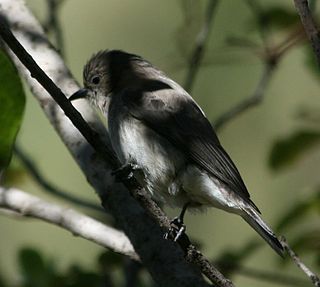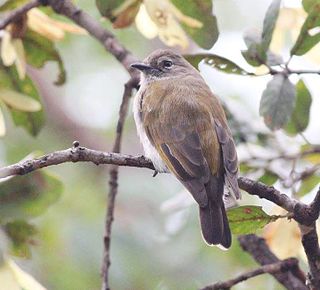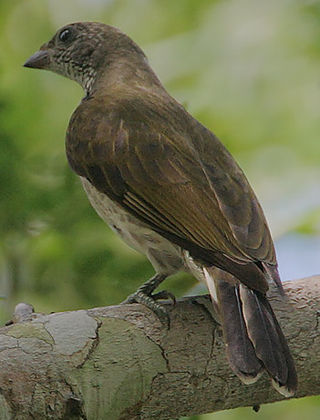
Honeyguides are a family of birds in the order Piciformes. They are also known as indicator birds, or honey birds, although the latter term is also used more narrowly to refer to species of the genus Prodotiscus. They have an Old World tropical distribution, with the greatest number of species in Africa and two in Asia. These birds are best known for their interaction with humans. Honeyguides are noted and named for one or two species that will deliberately lead humans directly to bee colonies, so that they can feast on the grubs and beeswax that are left behind.

The greater honeyguide is a bird in the family Indicatoridae, paleotropical near passerine birds related to the woodpeckers. Its English and scientific names refer to its habit of guiding people to bee colonies. Claims that it also guides non-human animals are disputed.

The Yao people are a major Bantu ethnic and linguistic group living at the southern end of Lake Malawi. They played an important role in the history of Southeast Africa, notably in the 19th century. The Yao are a predominantly Muslim-faith group of about two million, whose homelands encompass the countries of Malawi, the north of Mozambique, and the Ruvuma and Mtwara Regions of Tanzania. The Yao have a strong cultural identity, transcending national borders.

The yellow-rumped honeyguide is a sparrow-sized bird in the honeyguide family that is found in Asia, mainly in montane forests along the Himalayas. They are very finch-like but the feet are strong and zygodactyl, with two toes facing forward and two backward. They perch on honeycombs and feed on wax. Males tend to be territorial and stay near honeycombs while females and juveniles forage widely. They are brood parasites, laying their eggs in the nests of tree-hole breeders, possibly barbets.

The Malaysian honeyguide is a bird in the family Indicatoridae, which are paleotropical near passerine birds related to the woodpeckers. The species is native to Southeast Asia.

Sjöstedt's greenbul is a species of songbird in the bulbul family, Pycnonotidae. It is found in western and central Africa.

The honeyguide greenbul is a species of songbird in the bulbul family, Pycnonotidae. It is widespread throughout the African tropical rainforest.

The least honeyguide is a small species of bird in the family Indicatoridae. It is found in sub-Saharan Africa.

The pallid honeyguide is a species of bird in the family Indicatoridae. The species is also known as the eastern least honyeguide. It is found in Angola, Democratic Republic of the Congo, Kenya, Malawi, Mozambique, Tanzania, Uganda, Zambia, and Zimbabwe.

The lesser honeyguide is a species of bird in the family Indicatoridae. Like other honeyguides, it is a brood parasite that lays eggs most commonly in the nests of African barbets, but will also occasionally use the nests of other birds as well, such as starlings and woodpeckers.

The scaly-throated honeyguide is a species of bird in the family Indicatoridae. They have a mutualistic relationship with humans in which they attract beekeepers towards bees' nests and then feeding on the remains, especially larvae.

The yellow-footed honeyguide is a species of bird in the family Indicatoridae. It is found in Cameroon, Guinea, Liberia, Sierra Leone, Ivory Coast, Ghana and Nigeria. Its natural habitat is subtropical or tropical moist lowland forests. It is threatened by loss of its forest habitat.

Zenker's honeyguide is a species of bird in the family Indicatoridae. It is found in Cameroon, Central African Republic, Republic of the Congo, Democratic Republic of the Congo, Equatorial Guinea, Gabon, and Uganda.

The brown-backed honeybird, also known as Wahlberg's honeybird, Wahlberg's honeyguide and sharp-billed honeyguide, is a species of bird in the family Indicatoridae. This bird is named after the Swedish naturalist Johan August Wahlberg.

The green-backed honeybird, also known as the eastern green-backed honeyguide, green-backed honeyguide and slender-billed honeyguide, is a species of bird in the family Indicatoridae. It is a nest parasite of the Northern yellow white-eye.

Indicator is a genus of near passerine birds in the honeyguide family. The name refers to the behaviour of some species, notably the greater honeyguide, which guide humans to bee colonies so that they can share in the spoils of wax and insects when the nest is broken into.

Picides is an infraorder of the order Piciformes that includes woodpeckers and honeyguides. The honeyguides were thought to be closely related to the barbets, as their aerial displays and vocalizations are more similar to each other than either are to woodpeckers. However, phylogenetic analysis has shown that honeyguides and woodpeckers are indeed sister taxa.
Georg August Zenker was a German gardener and naturalist.
























